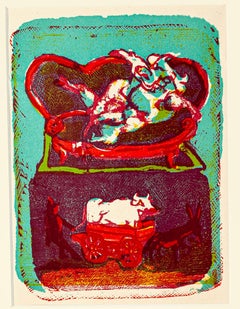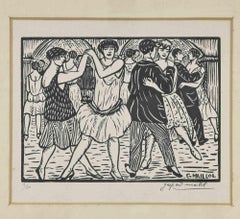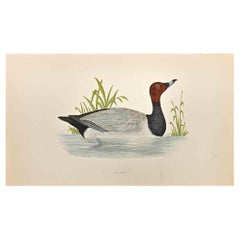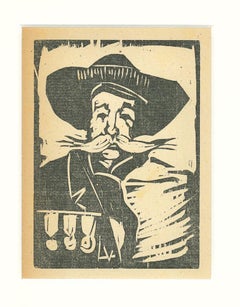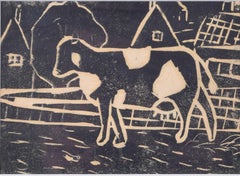Art by Medium: Woodcut
to
1,509
3,583
490
327
179
269
Overall Width
to
Overall Height
to
52
744
3,451
607
30
102
438
309
161
215
399
165
162
121
28
2,427
591
249
214
205
110
57
45
41
25
5
3
1
1
3,403
1,302
120
2,334
1,206
889
841
619
467
459
401
394
366
354
275
242
216
212
183
176
145
132
105
4,855
184,160
97,065
78,324
77,290
170
151
57
50
47
381
2,263
1,898
1,865
Medium: Woodcut
Bernard, Composition, Éloge de Émile Bernard (after)
Located in Southampton, NY
Woodcut on vélin d’Arches paper. Inscription: unsigned and unnumbered, as issued. Good condition. Notes: From the volume, Éloge de Émile Bernard, 1962. Published by Editions d'Art Ma...
Category
1960s Post-Impressionist Art by Medium: Woodcut
Materials
Woodcut
$796 Sale Price
20% Off
Relaxing Bull - Original Woodcut Print by Mino Maccari - Mid 20th Century
By Mino Maccari
Located in Roma, IT
Relaxing Bull is an original woodcut print realized by Mino Maccari.
Included a white Passepartout: 49 x 34 cm.
The state of preservation is very good except for small riping along...
Category
Mid-20th Century Art by Medium: Woodcut
Materials
Woodcut
Dance Hall - Woodcut by Gaspard Maillol - Early 20th Century
Located in Roma, IT
Dance hall is a woodcut print realized by Gaspard Maillol (1880-1946).
Hand signed by the artist on the lower margin. Edition 19/160.
Gaspard Maillol , born on July 10 , 1880 in Ba...
Category
Early 20th Century Modern Art by Medium: Woodcut
Materials
Woodcut
Pochard - Woodcut Print by Alexander Francis Lydon - 1870
Located in Roma, IT
Pochard is a modern artwork realized in 1870 by the British artist Alexander Francis Lydon (1836-1917).
Woodcut print on ivory-colored paper.
...
Category
1870s Modern Art by Medium: Woodcut
Materials
Woodcut
Portrait - Woodcut by Lorenzo Viani - 1930
Located in Roma, IT
Portrait is an original woodcut on paper, realized by the Italian Artist Lorenzo Viani in 1930 ca.
The State of preservation is excellent.
Monogrammed...
Category
1930s Modern Art by Medium: Woodcut
Materials
Woodcut
Heading out to Pasture, woodblock print by Penelope Ellis
Located in London, GB
Penelope Ellis (1935-2016)
Heading out to Pasture
Woodblock print
11 x 16 cm
Provenance: From the artist's estate sale.
Penelope Mary Ellis (1935–2016) was a British artist celeb...
Category
1950s Folk Art Art by Medium: Woodcut
Materials
Woodcut
Ex libris - Fr. Novy - Woodcut by Ladislav Rusek - 1967
Located in Roma, IT
Ex- Libris - Fr. Novy is an Artwork realized in 1967 by the Artist Ladislav Rusek (1927-2012)
Woodcut print on ivory paper. The work is glued on green cardboard. Hand Signed on the ...
Category
1960s Modern Art by Medium: Woodcut
Materials
Paper, Woodcut
$149 Sale Price
30% Off
Actors - Woodcut Print by Utagawa Sadafusa - 1820s
By Utagawa Sadafusa
Located in Roma, IT
Actors is an original modern artwork realized in 1820-1830 by Utagawa Sadafusa.
Woodcut Print Oban Dyptich Format.
Arashi Kanjuro as Benkei, Ichikawa Komazo as Minamoto Yoshitsune ...
Category
19th Century Modern Art by Medium: Woodcut
Materials
Woodcut
Composition (Morane, N° 100), Les Petites Fleurs de St. Françoise, Émile Bernard
Located in Southampton, NY
Wood engraving on vergé d'Arches paper. Inscription: unsigned and unnumbered, as issued. Good condition. Notes: From the volume, Les Petites Fleurs de St. François, 1928. Published b...
Category
1920s Post-Impressionist Art by Medium: Woodcut
Materials
Woodcut
Ripple
Located in Columbia, MO
Kristen Martincic earned her BFA from Bowling Green State University and her MFA from the University of Nebraska-Lincoln. The artist, who currently lives and works in Columbia, Misso...
Category
21st Century and Contemporary Contemporary Art by Medium: Woodcut
Materials
Mulberry Paper, Woodcut
Meeting of Two Samurai - Woodcut Print by Utagawa Kuniyasu - 1820
Located in Roma, IT
Meeting of two samurai is an original modern artwork realized by Utagawa Kuniyasu in 1820.
Woodcut Print Oban Dyptich Format. Meeting of two samurai ...
Category
19th Century Modern Art by Medium: Woodcut
Materials
Woodcut
Portrait of a Samurai - Woodcut by Utagawa Kunisada - 1860s
Located in Roma, IT
Oriental Warrior is an original print realized in the first half of the XIX century by Utagawa Kunisada.
Beautiful colored woodblock print.
This wonderful woodcut by Utagawa Kunisa...
Category
1860s Modern Art by Medium: Woodcut
Materials
Woodcut
Portrait of the Actor Nakamura Shikan - Woodcut Print by Masunao - 1847
Located in Roma, IT
Half-length portrait of the actor Nakamura Shikan is an original modern artwork realized by Masunao in 1847.
Original Woodcut Print Chuban Format, 1847.
From the series "Shukoku se...
Category
19th Century Modern Art by Medium: Woodcut
Materials
Woodcut
The Artist - Original Woodcut by René Perrot - Mid-20th Century
Located in Roma, IT
The Artist is an original Woodcut print realized by René Perrot in the Mid-20th century.
Good conditions.
Signed on the plate.
The artwork is depicted t...
Category
Mid-20th Century Modern Art by Medium: Woodcut
Materials
Woodcut
"Enshoku Sanju-roku Kasen" (Thirty-six Enchanting Flowers) Woodblock on paper
Located in Soquel, CA
"Enshoku Sanju-roku Kasen" (Thirty-six Enchanting Flowers) Woodblock on paper
Elegant woodblock print by Toyohara Kunuchika (Japanese, 1835-1900). Three women are in talking with each other inside, while a man waits outside holding a bag of some kind. The colors in this piece are rich and saturated, primarily blues, greens, and purple.
Mat size: 16"H x 20"W
Paper size: 14.75"H x 9.88"W
Born in 1835, Toyohara Kunichika grew up in the Kyobashi district of Edo in the midst of merchants and artisans. In 1848, at age 13, he was accepted as an apprentice into the studio of Utagawa Kunisada I...
Category
1880s Edo Art by Medium: Woodcut
Materials
Ink, Rice Paper, Woodcut
Tide Race, Japanese Woodcut Art, Ocean Art, Art for your Beach House, Coastal
Located in Deddington, GB
Tide Race by Artist Rod Nelson is a limited edition print. The scene captures the violently beautiful way in which waves crash.
Rod Nelson is a printmaker w...
Category
21st Century and Contemporary Contemporary Art by Medium: Woodcut
Materials
Paper, Woodcut
La Lettre du Fils (The Son's Letter)
Located in San Francisco, CA
This artwork titled "La Lettre du Fils" (The Son's Letter) 1938 is an original color woodcut by French artist Paul Jacoulet, 1896-1960. It is hand signed in pencil by the artist, wit...
Category
Mid-20th Century Realist Art by Medium: Woodcut
Materials
Woodcut
'Bowling Angel', Post Impressionist, Portland Museum, Albright-Knox Gallery
By Dan May
Located in Santa Cruz, CA
Signed lower left, 'May' for Dan May (American, 1952-2019) with number and limitation, '1/50'. Titled, lower center, 'Bowling Angel' and dated, lower right, '2003'.
Sheet dimensions:...
Category
Early 2000s Art by Medium: Woodcut
Materials
Paper, Woodcut
Latin American Judaica Conceptual Chassidic Art Modern Woodcut Luis Camnitzer
Located in Surfside, FL
Luis Camnitzer and Martin Buber (1878-1965),
New York: JMB Publishers Ltd, 1970.
Printed at The New York Graphic Workshop.
Hand signed on Arches paper. (Edition 24/100, numbered on Justification page)
Woodblock prints based on folktales from the Hasidic Jewish tradition in Eastern Europe, selected by Camnitzer from the early masters section of Buber’s Die chassidischen Bücher as translated by Olga Marx. German Expressionist style Jewish woodcuts...
Category
1970s Expressionist Art by Medium: Woodcut
Materials
Woodcut
Kabukie - The Province of Rokuok - Woodcut by Utagawa Kunikazu - 1862
By Utagawa Kunikazu
Located in Roma, IT
Kabukie - The Province of Rokuoku is an original artwork realized in 1862 by Utagawa Kunikazu (1830 - 1919)
Chuban.
From the series "Dai Nippon rokuju of Rikuoku" (60 provinces of Glorious Japan), The Province of Rokuoku.
Meeting of the two rivals in the forest at night, Tanigoro with sumo apron and fan with the national colours.
Signed: Kunikazu.
Good impression, backed, glued at corners, oxidation, centrefold, a little bit rubbed.
Utagawa Kunikazu (1830 - 1919) was a printmaker from Osaka. He had a famous teacher, the ukiyo-e artist Kunisada Utagawa...
Category
1860s Modern Art by Medium: Woodcut
Materials
Woodcut
Kabuki - Scene in the Snow - Woodcut by Utagawa Kunisada - 1864
Located in Roma, IT
Kabuki - Scene in the snow is an original artwork realized in 1864 by Utagawa Kunisada II (1823 – 20 July 1880).
Oban from a triptych.
Scene in a snowy ...
Category
1850s Modern Art by Medium: Woodcut
Materials
Woodcut
ENCLOSURE 12
By Kunihiro Amano
Located in Portland, ME
Amano, Kunihiro (Japanese, born 1929). ENCLOSURE 12. Color Woodblock, not dated. Edition of 30. Titled, Numbered 21/30, and signed in pencil. 18 x 13 1/2 inches. In excellent condit...
Category
Mid-20th Century Art by Medium: Woodcut
Materials
Woodcut
White Owl - Woodcut Print by Alexander Francis Lydon - 1870
Located in Roma, IT
White Owl is a modern artwork realized in 1870 by the British artist Alexander Francis Lydon (1836-1917) .
Woodcut print, hand colored, published by Londo...
Category
1870s Modern Art by Medium: Woodcut
Materials
Woodcut
Yakushae - Woodcut Print by Utagawa Kunisada - 1863
Located in Roma, IT
Yakushae is an original modern artwork realized by Utagawa Kunisada in 1863.
Woodcut print oban from a tryptich. Signed Toyokuni ga. Publisher: Izutsuya. Scene from the play "Yowa Nasake Ukina no Yokogushi". Yasugoro, the thief with the bat tattoo on his cheek, enters the oil merchant's house at night...
Category
19th Century Modern Art by Medium: Woodcut
Materials
Woodcut
"In Memorium Rene Beeh" original woodcut
Located in Henderson, NV
Medium: original woodcut. This impression on laid paper was printed in Germany in 1922 for the rare Ganymed portfolio "Das vierte Jahrbuch der Marees Gesellschaft" and published in M...
Category
1920s Expressionist Art by Medium: Woodcut
Materials
Woodcut
The Celestial Scale - Woodcut - 1963
Located in Roma, IT
The Celestial Scale - "The Divine Comedy" - Song 21 - Paradise is a woodcut print realized in 1963 for a series illustrating the Medieval poem of the "Divine Comedy" by Dante Aligh...
Category
1960s Surrealist Art by Medium: Woodcut
Materials
Woodcut
$346 Sale Price
35% Off
Little Spring Horse - Woodcut Print by Keisai Eisen - 1830s
By Keisai Eisen
Located in Roma, IT
Little Spring Horse is an original modern artwork realized by Keisai Eisen in 1820-30.
Woodcut Print Oban Format From the series "Osana asobi" (Children'...
Category
19th Century Modern Art by Medium: Woodcut
Materials
Woodcut
Kabuki - Woodcut by Sawamura Tanosuke - 1862
Located in Roma, IT
Kabuki is an original artwork realized in 1862.
Breast portrait of the actor Sawamura Tanosuke in front of a dark blue background, as Kanehira's daughter, in the inset portrait of B...
Category
1860s Modern Art by Medium: Woodcut
Materials
Woodcut
Imperfect Print for B.A.M.
Located in London, GB
Woodcut and screenprint in colours, 1987, on Arches wove paper, signed and dated in pencil from the edition of 75, published by Parasol Press, Ltd., New York, from The Brooklyn Acade...
Category
1980s Abstract Art by Medium: Woodcut
Materials
Color, Screen, Woodcut
Ex Libris - Giorgio Balbi - Woodcut - Mid-20th Century
Located in Roma, IT
Ex Libris - Giorgio Balbi is an Artwork in Mid 20th Century.
Woodcut.
Good conditions.
Category
Mid-20th Century Modern Art by Medium: Woodcut
Materials
Woodcut
Kabuki - Woodcut Print by Utagawa Kunisada - 1864
Located in Roma, IT
Kabuki is an original artwork realized in 1864 by Utagawa Kunisada (1786-1865).
Breast portrait of the actor Sawamura Toshi in front of a dark blue background, he's wearing a lion dance costume. In the inset portrait of Kataoka Nizaemon with a feather costume.
Signed: Oshio Toyokuni ga (77 Toyokuni).
Publisher: Ebiya Rinnosuke in Horie. Censorship: Aratame. Wood engraver: Matsushima Masakichi.
Excellent impression with visible wood grain and baren print lines...
Category
1860s Modern Art by Medium: Woodcut
Materials
Woodcut
Composition, Description of a Masque, Jane Freilicher
Located in Southampton, NY
Woodcut on vélin Tosa Hanga à la main paper. Paper Size: 16 x 12 inches. Inscription: Unsigned and unnumbered, as issued. Notes: From the album, Description of a Masque, 1998. Publis...
Category
1990s Academic Art by Medium: Woodcut
Materials
Woodcut
$1,436 Sale Price
20% Off
KATSURA KYOTO I
Located in Portland, ME
Saito, Kiyoshi. KATSURA KYOTO I. Color Woodblock, 1962. Edition of 200. Titled, dated and numbered 84/200 in pencil. Signed in the block (prints from thi...
Category
1960s Art by Medium: Woodcut
Materials
Adhesive, Woodcut
1943 Israeli German Expressionist Woodcut Print Vintage Woodblock Bezalel School
By Jacob Pins
Located in Surfside, FL
Jacob Otto Pins (17 January 1917 – 4 December 2005) was a German-born Israeli woodcut artist and art collector, particularly of Japanese prints and paintings.
Jacob Pins was born in Höxter, Germany, the son of Dr Leo Pins, a veterinarian, and his wife Ida Lipper. He immigrated to Palestine in 1936 to study art. His father tried to discourage him from becoming an artist for financial reasons.
Pins' younger brother, Rudolph, (1920-2016) moved to the United States in 1934. His father was sent to Buchenwald. In July 1944, both parents died in the Riga ghetto.
Pins first lived on a kibbutz, which was disbanded in 1941. He moved to Jerusalem and studied woodcut and linocut under woodcut master and painter Jacob Steinhardt, also a German immigrant, at his small private school. He lived in poverty in a tiny room, subsisting on a meagre diet. He continued his studies at the new Bezalel Academy of Art and Design.
Pins was married to Elsa, the subject of a number of his prints. They had no children.
Pins bought his first Oriental print in 1945, and acquired a house on Ethiopia Street, opposite the Ethiopian church, where he lived for the rest of his life. He continued collecting until his death and was one of Israel's foremost art collectors. His book on Japanese Pillar Prints, Hashira-e is the definitive work on the subject.
Pins died in Jerusalem in December 2005.
Pins' artwork was heavily influenced by German expressionism and traditional Japanese wood block printing. From 1956 to 1977, he taught at Israel's leading art schools, most notably Bezalel, where he later became a professor. He was known as a demanding teacher, emphasizing strong technical skills and discipline.
In the 1950s, Pins helped to found the Jerusalem Artists' House, a centre for the city's artists to meet and exhibit.
Legacy
Pins' extensive collection of Japanese woodprints...
Category
1940s Expressionist Art by Medium: Woodcut
Materials
Woodcut
Three leaves (taro) - Landscape Print - Woodcut Print By Marc Zimmerman
Located in Carmel, CA
Minimal image in black ink on buff rice paper. Taro leaves are a simple form inspiring this woodcut print.
Three leaves (taro) - Landscape Print - Woodcut Print By Marc Zimmerman
T...
Category
2010s American Modern Art by Medium: Woodcut
Materials
Woodcut
Auti te pape (Les Femmes à la Rivière) - Woodcut After Paul Gauguin 1891
Located in Roma, IT
Original woodcut after Paul Gauguin.
Second edition of 100 prints signed by the Artist's son Pola Gauguin: lower left "Paul Gauguin fait", lower left "Pola Gauguin imp.". Inscribed ...
Category
1890s Post-Impressionist Art by Medium: Woodcut
Materials
Woodcut
Wallowing in the Mud, woodblock print by Penelope Ellis
Located in London, GB
Penelope Ellis (1935-2016)
Wallowing in the Mud
Woodblock print
15 x 11 cm
Provenance: From the artist's estate sale.
Penelope Mary Ellis (1935–2016) was a British artist celebra...
Category
1950s Folk Art Art by Medium: Woodcut
Materials
Woodcut
WPA Expressionist woodblock print. "The Worker"
Located in Surfside, FL
Pencil signed original limited edition woodcut woodblock print great depression era. from the 1930s.
Abramovitz, Albert 1879-1963
Born in Riga, Latvia, Abramovitz studied art at th...
Category
1930s Art by Medium: Woodcut
Materials
Woodcut
Lord on the Sand Castle - XX century Black & White Woodcut Print
Located in Warsaw, PL
Illustration for Jules de la Medelen's "Lord on the Sand Castle" ("Le Marquis Des Saffras")
FRANCISZEK BUNSCH (born in 1926) Franciszek Bunsch was born in Bielsko in 1926. He studie...
Category
1950s Contemporary Art by Medium: Woodcut
Materials
Woodcut, Paper
Ex-Libris - Navarra - woodcut - Mid 20th Century
Located in Roma, IT
Ex-Libris - Navarra is an Artwork realized in Mid 20th Century.
Woodcut on paper.
Good conditions.
The artwork represents a minimalistic, clean design, through preciseness .
Category
Mid-20th Century Modern Art by Medium: Woodcut
Materials
Woodcut
$113 Sale Price
40% Off
Flute-Like Voices, Abstract Woodcut Print by Bruce Porter
By Bruce Porter
Located in Long Island City, NY
Artist: Bruce Porter, American (1948 - )
Title: Flute-Like Voices
Year: 1993
Medium: Woodcut on Wove paper, signed and numbered in pencil
Edition: 11/20
Image Size: 33 x 23.5 inches
Category
1990s Abstract Art by Medium: Woodcut
Materials
Woodcut
Tsukioka Yoshitoshi (1839-1892) -1866 Japanese Woodblock, Battle Of Kawanakajima
Located in Corsham, GB
An extraordinary ukiyo-e triptych by one of the greatest ukiyo-e artists of the 19thC, Tsukioka Yoshitoshi (1839-1892). The triptych shows a dramatic scene from the epic, bloody four...
Category
Mid-19th Century Art by Medium: Woodcut
Materials
Woodcut
Kuwana Station - Woodcut after Utagawa Hiroshige -1920s
Located in Roma, IT
Kuwana Station is an original modern artwork realized after Utagawa Hiroshige (1797 – 12 October 1858) in 1920s.
Original woodcut print oban yokoe. After the famous Tokaido series, ...
Category
1920s Modern Art by Medium: Woodcut
Materials
Woodcut
$266 Sale Price
25% Off
Katsushika Hokusai -- POEM BY BUNYA NO ASAYASU (FUMIYA NO ASAYASU) 百人一首
Located in BRUCE, ACT
Katsushika Hokusai (Japanese, 1760–1849)
Poem by Bunya no Asayasu (Fumiya no Asayasu), from the series One Hundred Poems Explained by the Nurse (Hyakunin isshu uba ga etoki)
「百人一首うはか...
Category
1830s Art by Medium: Woodcut
Materials
Woodcut
Visit - Original Woodcut Print by Jules Chadel - Late 19th Century
Located in Roma, IT
Visit is an original artwork realized by Jules Chadel (1870-1941). Woodcut print. Hand signed on the lower right. Is not dated but we can attribute the period late 19th Century. Passpartout cm 44,5x32,5
The artist presents an interior of a room with men talking around a bad.
Good condition.
Jules Chadel (1870-1941) was a french artist who was born in 1870. He studied in Paris at the Ecole des Arts Décoratifs. Around 1903 his skills as a draftsman landed him jobs with jewelry designers. This also led him to discover Japanese...
Category
Late 19th Century Modern Art by Medium: Woodcut
Materials
Woodcut
Rare 1923 Cubist Reuven Rubin Woodcut Woodblock Kabbalah Print Israeli Judaica
By Reuven Rubin
Located in Surfside, FL
This is from the original first edition 1923 printing. there was a much later edition done after these originals.
These are individually hand signed in pencil by artist as issued.
This listing is for the one print. the other documentation is included here for provenance and is not included in this listing.
The various images inspired by the Jewish Mysticism and rabbis and mystics of jerusalem and Kabbalah is holy, dramatic and optimistic Rubin succeeded to evoke the spirit of life in Israel in those early days.
They are done in a modern art style influenced by German Expressionism, particularly, Ernst Barlach, Ernst Ludwig Kirchner, and Franz Marc, as introduced to Israel by Jakob Steinhardt, Hermann Struck and Joseph Budko.
Reuven Rubin 1893 -1974 was a Romanian-born Israeli painter and Israel's first ambassador to Romania.
Rubin Zelicovich (later Reuven Rubin) was born in Galati to a poor Romanian Jewish Hasidic family. He was the eighth of 13 children. In 1912, he left for Ottoman-ruled Palestine to study art at Bezalel Academy of Art and Design in Jerusalem. Finding himself at odds with the artistic views of the Academy's teachers, he left for Paris, France, in 1913 to pursue his studies at the École Nationale Supérieure des Beaux-Arts. He was of the well known Jewish artists in Paris along with Marc Chagall and Chaim Soutine,
At the outbreak of World War I, he was returned to Romania, where he spent the war years.
In 1921, he traveled to the United States with his friend and fellow artist, Arthur Kolnik. In New York City, the two met artist Alfred Stieglitz, who was instrumental in organizing their first American show at the Anderson Gallery. Following the exhibition, in 1922, they both returned to Europe. In 1923, Rubin emigrated to Mandate Palestine.
Rubin met his wife, Esther, in 1928, aboard a passenger ship to Palestine on his return from a show in New York. She was a Bronx girl who had won a trip to Palestine in a Young Judaea competition. He died in 1974.
Part of the early generation of artists in Israel, Joseph Zaritsky, Arieh Lubin, Reuven Rubin, Sionah Tagger, Pinchas Litvinovsky, Mordecai Ardon, Yitzhak Katz, and Baruch Agadati; These painters depicted the country’s landscapes in the 1920s rebelled against the Bezalel school of Boris Schatz. They sought current styles in Europe that would help portray their own country’s landscape, in keeping with the spirit of the time. Rubin’s Cezannesque landscapes from the 1920s were defined by both a modern and a naive style, portraying the landscape and inhabitants of Israel in a sensitive fashion. His landscape paintings in particular paid special detail to a spiritual, translucent light. His early work bore the influences of Futurism, Vorticism, Cubism and Surrealism.
In Palestine, he became one of the founders of the new Eretz-Yisrael style. Recurring themes in his work were the bible, the prophet, the biblical landscape, folklore and folk art, people, including Yemenite, Hasidic Jews and Arabs. Many of his paintings are sun-bathed depictions of Jerusalem and the Galilee. Rubin might have been influenced by the work of Henri Rousseau whose naice style combined with Eastern nuances, as well as with the neo-Byzantine art to which Rubin had been exposed in his native Romania. In accordance with his integrative style, he signed his works with his first name in Hebrew and his surname in Roman letters.
In 1924, he was the first artist to hold a solo exhibition at the Tower of David, in Jerusalem (later exhibited in Tel Aviv at Gymnasia Herzliya). That year he was elected chairman of the Association of Painters and Sculptors of Palestine. From the 1930s onwards, Rubin designed backdrops for Habima Theater, the Ohel Theater and other theaters.
His biography, published in 1969, is titled My Life - My Art. He died in Tel Aviv in October 1974, after having bequeathed his home on 14 Bialik Street and a core collection of his paintings to the city of Tel Aviv. The Rubin Museum opened in 1983. The director and curator of the museum is his daughter-in-law, Carmela Rubin. Rubin's paintings are now increasingly sought after. At a Sotheby's auction in New York in 2007, his work accounted for six of the ten top lots. Along with Yaacov Agam and Menashe Kadishman he is among Israel's best known artists internationally. Education
1912 Bezalel Academy of Arts and Design, Jerusalem
1913-14 École des Beaux Arts, Paris and Académie Colarossi, Paris
Select Group Exhibitions
Eged - Palestine Painters Group Eged - Palestine Painters Group, Allenby Street, Tel Aviv 1929
Artists: Chana Orloff, Abraham Melnikoff, Rubin, Reuven Nahum Gutman, Sionah Tagger,Arieh Allweil,
Jewish Artists Association, Levant Fair, Tel Aviv, 1929
Artists: Ludwig Blum,Eliyahu Sigad, Shmuel Ovadyahu, Itzhak Frenel Frenkel,Ozer Shabat, Menahem Shemi...
Category
1920s Abstract Art by Medium: Woodcut
Materials
Woodcut
Kabuki Aizurie - Woodcut by Utagawa Kunisada - 1852
Located in Roma, IT
Kabuki Aizurie is an original artwork realized in 1852 by Utagawa Kunisada (1786-1865).
The lovers Osome and Hisamatsu on the run at night, the roles played by Ichikawa Danjuro and...
Category
1860s Modern Art by Medium: Woodcut
Materials
Woodcut
Portrait of André Breton - Woodcut Print - Early 1900
Located in Roma, IT
Portrait of André Breton is an original black and white xylograph realized by Anonymous artist at the second half of the 20th Century.
The artwork depict...
Category
Early 20th Century Art by Medium: Woodcut
Materials
Woodcut
$315 Sale Price
30% Off
Orange labyrinth - XXI Century, Contemporary Linocut & Woodcut Print, Abstract
Located in Warsaw, PL
MARIA STELMASZCZYK (born in 1983) Studies at the Faculty of Graphic Arts and Painting
Laboratory of Woodcut Techniques and Artistic Book at the Academy of Fine Arts Władysław Strzemi...
Category
Early 2000s Contemporary Art by Medium: Woodcut
Materials
Paper, Linocut, Woodcut
wood engraving for Mille Nuits
Located in Henderson, NV
Medium: wood engraving (after the watercolor). Printed in Paris in 1955 at the atelier Coulouma for "Mille nuits et une nuit" (1001 Nights) which was the last major portfolio by Kees...
Category
1950s Art by Medium: Woodcut
Materials
Engraving, Woodcut
Constellation - XXI Century, Contemporary Linocut & Woodcut Print, Abstract
Located in Warsaw, PL
MARIA STELMASZCZYK (born in 1983) Studies at the Faculty of Graphic Arts and Painting
Laboratory of Woodcut Techniques and Artistic Book at the Academy of Fine Arts Władysław Strzemi...
Category
Early 2000s Contemporary Art by Medium: Woodcut
Materials
Paper, Linocut, Woodcut
wood engraving for Mille Nuits
Located in Henderson, NV
Medium: wood engraving (after the watercolor). Printed in Paris in 1955 at the atelier Coulouma for "Mille nuits et une nuit" (1001 Nights) which was the last major portfolio by Kees...
Category
1950s Art by Medium: Woodcut
Materials
Engraving, Woodcut
Face of a Woman, Figurative Abstract Pop Art Woodcut Portrait on Handmade Paper
By Paula Walzer
Located in Soquel, CA
Face of a Woman, Figurative Abstract Pop Art Woodcut Portrait on Handmade Paper
Bold pop art woodcut print on handmade paper of a woman's face in black and red, repeated in 4 vertical registers like a film strip, by Monterey Bay artist Paula Walzer...
Category
Late 20th Century Pop Art Art by Medium: Woodcut
Materials
Paper, Handmade Paper, Woodcut
Standing Nude - Original Woodcut On Rigid Paper- 1976
Located in Roma, IT
Standing Nude is a original artwork realized in 1976 by the Spanish artist José A.Benasalvas.
Original Woodcut on rigid paper.
Edition of 25 prints. Hand-signed by the artist on t...
Category
1970s Modern Art by Medium: Woodcut
Materials
Woodcut
Portrait of Cardinal - Woodcut after Albrecht Durer - Early 20th Century
Located in Roma, IT
Portrait of Cardinal Albrecht of Brandenburgr is a Woodcut print on cream-colored paper. realized after Albrecht Durer, a reproduction of the early 20th...
Category
Early 20th Century Modern Art by Medium: Woodcut
Materials
Woodcut
Ex-Libris - C.J. Vaandrager - woodcut - Mid 20th Century
Located in Roma, IT
Ex-Libris - C.J. Vaandrager is an Artwork realized in Mid 20th Century.
Etching on paper. Hand signed in pencil.
Good conditions.
The artwork represents a minimalistic, clean desi...
Category
Mid-20th Century Modern Art by Medium: Woodcut
Materials
Woodcut
$154 Sale Price
35% Off
Ex Libris - J.J. V. Lindt - woodcut - Mid 20th Century
Located in Roma, IT
Ex Libris - J.J. V. Lindt is a Modern Artwork realized in the mid-20th Century.
Woodcut print on paper.
The work is glued on a cardboard.
Good conditions.
Category
Mid-20th Century Modern Art by Medium: Woodcut
Materials
Woodcut
$71 Sale Price
40% Off
Osakae - Woodcut by Ichiyôsai Yoshitaki - 1860s
Located in Roma, IT
Osakae is an original artwork realized in the 1861 by Ichiyôsai Yoshitaki.
Woodcut print Chuban Diptych.
The actor Nakamura Jakuemon I as Matsushita Kaheiji, Arashi Rikan III as Ak...
Category
1860s Modern Art by Medium: Woodcut
Materials
Woodcut
wood engraving for Mille Nuits
Located in Henderson, NV
Medium: wood engraving (after the watercolor). Printed in Paris in 1955 at the atelier Coulouma for "Mille nuits et une nuit" (1001 Nights) which was the last major portfolio by Kees...
Category
1950s Art by Medium: Woodcut
Materials
Engraving, Woodcut
Bijin and Children on a Porch with Lanterns-Woodcut by Utagawa Kunisada II-1870s
Located in Roma, IT
Bijin and children on a porch with lanterns is an original modern artworks realized by Utagawa Kunisada II between 1860-1875
Mixed colored woodcut print (nishiki-e).
Format: ôban vertical triptych...
Category
19th Century Modern Art by Medium: Woodcut
Materials
Woodcut
Woodcut art for sale on 1stDibs.
Find a wide variety of authentic Woodcut art available on 1stDibs. While artists have worked in this medium across a range of time periods, art made with this material during the 21st Century is especially popular. If you’re looking to add art created with this material to introduce a provocative pop of color and texture to an otherwise neutral space in your home, the works available on 1stDibs include elements of orange, yellow, purple, blue and other colors. There are many well-known artists whose body of work includes ceramic sculptures. Popular artists on 1stDibs associated with pieces like this include Mino Maccari, Utagawa Kunisada (Toyokuni III), Eric Gill, and Utagawa Hiroshige. Frequently made by artists working in the Modern, Contemporary, all of these pieces for sale are unique and many will draw the attention of guests in your home. Not every interior allows for large Woodcut art, so small editions measuring 0.04 inches across are also available

